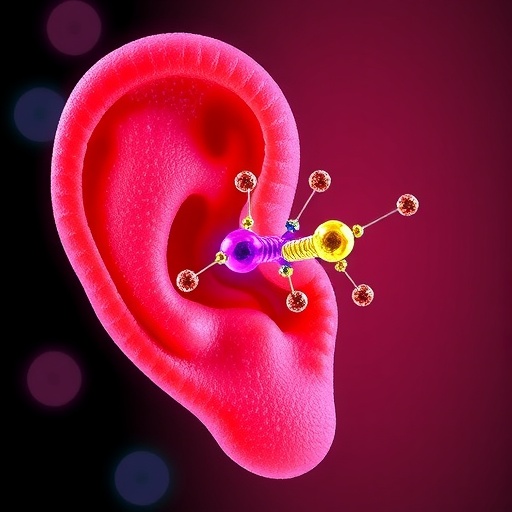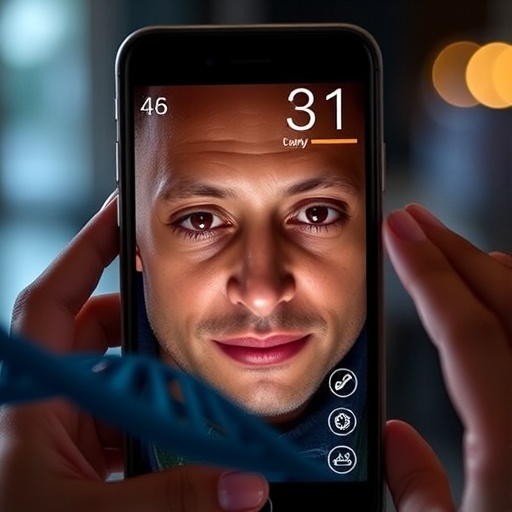In a groundbreaking study published in Journal of Translational Medicine, researchers have introduced an innovative approach to deliver treatments for hearing loss using mucoadhesive polydopamine-coated nanoparticles. This novel method promises to significantly enhance the efficacy of drug delivery to the inner ear, a region traditionally challenging to target effectively. Hearing loss affects millions worldwide, and the limitations of current therapeutic interventions necessitate a fresh take on drug delivery systems.
The inner ear’s intricate structure and protective barriers often hinder the effective administration of therapeutic agents. Conventional methods, such as systemic drug administration or direct injection, are fraught with challenges, including inadequate drug bioavailability and potential systemic side effects. In this study, researchers have sought to overcome these obstacles by utilizing nanoparticles that can enhance drug delivery accuracy and efficiency.
Polydopamine, a biomimetic material inspired by the adhesive properties of mussels, has garnered attention in the field of drug delivery due to its multifunctional characteristics. Its ability to adhere to biological surfaces allows it to create a stable vehicle for drug transportation, particularly in moist environments like the inner ear. This research exploits polydopamine’s unique properties to optimize the delivery of hearing loss therapeutics, focusing on enhancing the contact between the drug and the target tissue.
The study dives into the synthesis of mucoadhesive polydopamine-coated nanoparticles, detailing the meticulous process required to ensure their effectiveness. Researchers successfully created nanoparticles that are not only biocompatible but also exhibit strong adhesion to the mucosal surfaces of the inner ear. This adhesion is crucial, as it ensures prolonged retention of the drug at the site of action, thereby enhancing its therapeutic potential.
Additionally, the researchers evaluated the release profile of drugs from the polydopamine-coated nanoparticles. Controlled release is vital in drug delivery to avoid peak toxicity and ensure sustained therapeutic levels over time. By fine-tuning the formulation of these nanoparticles, the study reports a favorable drug release profile that mirrors the needs of the inner ear, thereby facilitating a more effective treatment regimen for patients suffering from hearing loss.
One of the key findings of the study is the enhanced cellular uptake of drugs when delivered via these mucoadhesive nanoparticles. Laboratory tests demonstrated significantly higher absorption rates of the active pharmaceutical ingredients compared with conventional delivery methods. This finding has critical implications for the treatment of conditions where drug absorption in the inner ear is paramount.
Furthermore, the researchers conducted in vivo studies to assess the therapeutic efficacy of the nanoparticle-mediated drug delivery system using an animal model. The results indicated a substantial improvement in hearing function post-treatment, suggesting that the nanoparticles not only facilitate drug delivery but also enhance the overall therapeutic outcome. These promising results pave the way for further clinical trials aimed at validating the safety and effectiveness of this delivery system in humans.
The implications of this research extend beyond just hearing loss treatment. The principles demonstrated through the development of mucoadhesive nanoparticles could be applied to various therapeutic areas, including other auditory diseases and conditions that require targeted drug delivery systems. As the scientific community continues to explore the full potential of nanotechnology in medicine, findings from this study could serve as a foundational piece for future innovations.
Significantly, the researchers emphasize the potential for this technology to lead to personalized medicine approaches in hearing loss treatment. With additional refinements to the nanoparticle design, practitioners could potentially tailor drug doses to match individual patient needs, maximizing therapeutic efficacy while reducing unwanted side effects.
As the translation of this technology from the laboratory to clinical settings progresses, it is essential for healthcare providers, researchers, and industry leaders to collaborate closely. The move towards innovative drug delivery methods is not only promising for hearing loss treatment but also for a myriad of ailments that require precision and targeted therapy.
The study’s authors believe that the future of hearing loss interventions lies in these innovative nanoparticle systems, which could revolutionize the way medical professionals approach treatment. By merging advanced materials science with pharmacology, they have set a new precedent for how drugs can be effectively delivered within the body, particularly to hard-to-reach areas.
In conclusion, the research conducted by Kim et al. heralds a new era in the treatment of hearing loss through targeted drug delivery using mucoadhesive polydopamine-coated nanoparticles. As researchers continue to build on these findings, there is hope for more effective therapies that could restore hearing for countless individuals worldwide. This work not only tackles a pressing health issue but also exemplifies the potential of cutting-edge nanotechnology in transforming modern medicine.
The journey from scientific discovery to real-world implementation is often fraught with challenges, yet the insights garnered from this study illuminate a path forward. As the narrative of hearing loss treatment unfolds, the integration of innovative delivery systems like polydopamine-coated nanoparticles may indeed represent the breakthrough needed to help those with hearing impairments regain their quality of life.
Subject of Research: Nanoparticle-mediated drug delivery for hearing loss treatment
Article Title: Mucoadhesive polydopamine-coated nanoparticle-mediated inner ear drug delivery for hearing loss treatment
Article References:
Kim, S., Cheon, S.Y., Yang, KJ. et al. Mucoadhesive polydopamine-coated nanoparticle-mediated inner ear drug delivery for hearing loss treatment.
J Transl Med 23, 1066 (2025). https://doi.org/10.1186/s12967-025-07103-z
Image Credits: AI Generated
DOI: 10.1186/s12967-025-07103-z
Keywords: Hearing loss, drug delivery, nanoparticles, polydopamine, mucoadhesive, inner ear.
Tags: biomimetic materials in medicineenhanced drug bioavailability in inner earhearing loss treatment advancementsinner ear drug administration challengesinnovative therapies for hearing lossJournal of Translational Medicine researchmucoadhesive nanoparticles for hearing lossmultifunctional nanoparticles for therapeuticsnanoparticle drug delivery systemsovercoming drug delivery obstacles in healthcarepolydopamine in drug deliverytargeted drug delivery to inner ear





